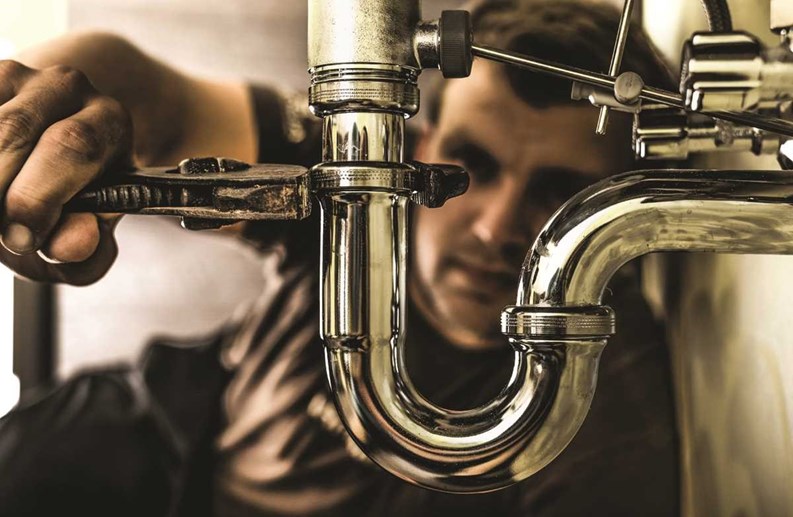Few things illustrate the fragility of modern civilization more clearly than plumbing problems. A broken pipe, a backed-up toilet, a flooded bathroom—any one of these can quickly go from annoyance to emergency, and the longer a plumbing problem lingers, the more unsavory the situation gets. Without efficient, functional plumbing, a densely populated urban or suburban area can go from metropolitan to medieval in very short order.
But how exactly does a building’s plumbing system work? That answer has been several hundred years in the making—and the more managers, boards, and residents know about how it all ties together to bring the good in and flush the bad out, the better prepared a building association will be if its own plumbing system develops problems.
Flood of Memories
According to Plumbing and Mechanical Magazine, the ancient Minoans hold the honor of being the first civilization with a flush toilet, located within the Palace of Knossos on the Greek island of Crete.
With increased engineering skill and the introduction of lead pipes, the Romans took plumbing up a few notches with fresh water (thanks to their awe-inspiring system of aqueducts), heated floors, grand bath houses, dams, drains and sewer systems.
Roman innovation didn’t last, however—from the Dark Ages to as late as the 1600s, folks were back to using chamber pots. Even more charming, they generally emptied those pots into the street—a habit that did little for public health and sanitation.
Early Americans didn’t fare much better—at least not at first. It wasn’t until the 1700s when a wooden pipe system was put in place in New York City that chamber pots began to be phased out.
The early 1800s finally saw construction of public waterworks systems, and by the 1900s, fewer and fewer Americans had to traipse across freezing yards to outhouses in the dead of night. Indoor plumbing became viewed less as a luxury and more as a basic necessity—so much so that from 1929 to 1954, purchases of indoor plumbing equipment rose more than 350 percent.
Modern Materials
Today, cast iron piping is gone and, according to a plumbing expert in Secaucus, water distribution systems are now made predominantly of copper or plastic. “Thirty or 40 years ago, brass piping was used for potable water, but now there's a mix of copper and PEX water piping, the latter being a new plastic piping popular for water distribution,” he says.
The acceptance of plastic piping varies in New Jersey by county and municipality. As he explains, even though there's a standardized plumbing code throughout the state, each municipal authority will dictate to local plumbers which materials they will allow in that particular municipality.
Indoor plumbing has come a long way from the days of carrying buckets of well water, but bringing water to the residents of a multifamily building is much different compared to a single family home. It also comes with its own set of challenges.
“Residents commonly complain about water temperature, leaks, blockages, stoppages and low water pressure,” says Harris Clark, a master plumber with Sanitary Plumbing & Heating Corp. in the Bronx.
In a single-family home, if the water is too hot or too cold, residents can simply adjust the temperature of the water heater. “In a multifamily building, everybody is going to get the same water temperature, because it’s one giant piece of equipment serving, say, 200 units. You can’t set the water temperature to meet everyone’s needs.”
Finding & Fixing
Durable as they are, pipes do eventually show their age, and all the water pressure pushing through them means that sooner or later, they will develop leaks. Other issues, like corrosion, and residents flushing inappropriate things down toilets and drains also leads to breakdowns and malfunctioning.
"Residents should only discard toilet paper that adequately breaks down," says the plumbing expert. "People frequently throw napkins or paper towels into toilets, resulting in problematic stoppages."
Finding the source of leaks is notoriously tough. “Sometimes it’s difficult to trace where it's coming from,” says Clark. “Did it start in the basement or five floors up? Is it on the west side of the building, or is it going across the beams and down two flights on to the east side of the building?”
Unfortunately leaks aren’t something that can be totally prevented. “In the plumbing world, you don’t fix something unless it’s leaking,” says Bob Bellini, president of Varsity Plumbing & Heating Inc. in Flushing (of course), Queens. “However, it is very important to get leaks under control right away, because we’ve learned a lot about mold in recent years. The more a pipe leaks, the more of a health issue it can be—so you must have a good communication system to report leaks as soon as they happen.”
According to the EPA, water leaks should be cleaned up within 24 to 48 hours of when they happen to prevent mold growth. “Don’t let things fester,” warns Clark. “If your super tells you there’s a leak somewhere, it’s only going to get worse—not better. Your bylaws will say who’s responsible for what repairs, but the general rule is what’s inside the wall is the building’s responsibility, while outside is the shareholder’s responsibility—but individual buildings may deviate a little.”
Leaks are annoying and, if not fixed, can lead to mold and other potential damage. However, nothing is more disruptive and uncomfortable for residents than stoppages and blockages, especially if it causes a neighbor’s water to back up into their unit. “ “There are a lot of variables as to what is causing blockages,” says Stuart Liben, president of New York City Plumbing & Heating Inc. in Manhattan. “Depending on the age of the building and the piping, it might be harder for the water to flush down.”
Unlike if-it-ain't-broke-don't-fix-it water pipes, sewer systems can definitely be maintained. “Have a plan to routinely clean them with a sewer machine,” says Bellini. “You are trying to get buildup out of there, so you’re less likely to have a backup.”
There are other steps you can take to care for the plumbing system, too. “When you are renovating, make sure any exposed piping is checked—and replaced if necessary,” says Liben, who goes on to explain that however competent and knowledgeable your in-house staff may be, professional licensed plumbers are more familiar with the intricacies of a building’s water supplying and waste removal systems. “Note the age of your hot water heaters, and make sure you have anti-flood devices that will shut the water down if there was a leak. For washing machines, make sure hoses are checked regularly, and that they also have a flood stop mechanism that shuts the water down.”
Bring in the Professionals
Just remember that supers aren’t plumbers, so call in the professionals when necessary. “Supers shouldn't handle any plumbing, because they're not licensed by the state of New Jersey, nor are they insured," explains the plumbing expert. "There have been instances of handymen running around, doing work against code in regard to ventilation problems, or running waste or water piping. If they were to break a trap seal, they'd also be breaking the law. Supers and handymen simply aren't versed on the codes and laws that the state puts forth to its licensed plumbers."
In addition to state regulations, professional plumbers must also be well-versed in the newest backflow preventer regulations. “It’s a device that’s installed by a licensed installer on the water main coming into the building,” says Bellini. "It prevents the water from any commercial or residential property from back flowing into the city pipes or sewer main.”
According to the New Jersey Department of Environmental Protection, state regulations require a physical connection permit be obtained by the owner of a facility (not a private residence) containing an unapproved water supply and a public community water supply. The permit has to be renewed annually and requires each backflow prevention device covered by the permit to be tested quarterly.
Pigeon Surprise
The work of a plumber might seem straight-forward—fix a leak or unstop a clog—but depending what’s behind the cause of the leak or the stoppage, plumbers might have some interesting stories to tell.
One of Bellini's unusual adversaries is the humble urban pigeon. “One day we got a phone call from a building that had no water. Their roof tank was full, but the water wasn’t flowing out of the tank. We suctioned out all of the water out of the main line and found a dead pigeon carcass blocking the water from going to the rest of the building. It’s so important to make sure the tank structure on the roof is maintained.”
The plumbing expert in Secaucus echoes Bellini's fowl encounter with some experiences of his own. "During heating season, we've actually pulled birds out of building boilers," he says. "They'll make their nests in a chimney, which are often not protected by a chimney thimble, which is a little grate that stops small animals from getting further inside. I've actually pulled out live birds and squirrels, saving them from an unfortunate appointment with a boiler."
In a winking tribute to his work, Clark says, “It’s a crapshoot as to whether or not we’ll find something unusual,” he says “We’ll find engagement rings, kids’ toys, makeup...and anything that can fit down a toilet.”
As with any system, the key to good plumbing is maintenance and repair. Take care of the system before something happens. This will avoid unnecessary grief later on, especially when residents are complaining. A simple leak that isn’t taken care of can cause a tremendous amount of damage to the unit and the co-op or condo building.
Lisa Iannucci is a freelance writer and a frequent contributor to The New Jersey Cooperator. Staff writer Michael Odenthal contributed to this article.







Leave a Comment